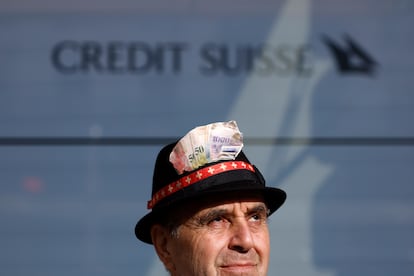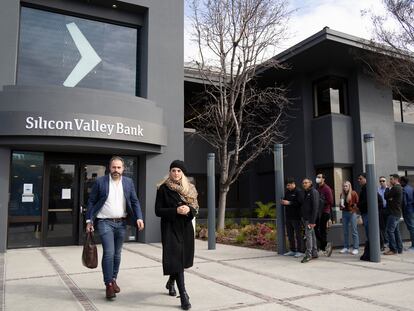Banking panics in high gear: money flies in the age of apps and social media
Cases such as those of Silicon Valley Bank and Credit Suisse show how the sector is facing new risks, such as the speed of fund outflows or the viral spread of bad news and rumors

The event went rather unnoticed. Several branches of Metro Bank in west London were suddenly besieged by hordes of customers demanding their money back as well as their jewelry stored in safe deposit boxes. It was May 2019, and word had spread via WhatsApp that their bankruptcy was near. The entity responded that these were unsubstantiated rumors. It fell on the stock market, but ended up calming down and survived. Four years later, a new wave of banking panics has hit the United States and Europe. And in all of them, one thing stands out: there have been no queues or they have been irrelevant to the final fate of the damaged entity.
— househusband (@househu55852411) May 13, 2019
Until recently, the words Silicon Valley were equated with success. When a country built a powerful technological ecosystem, the adjective was immediately attached to it. So it is with Bangalore, the Indian Silicon Valley. Or Shenzhen, China’s Silicon Valley. This month we learned that there was also a financial institution called Silicon Valley Bank (SVB), and when those two terms resonate, the mythology of start-ups born in garages now rivals a less dazzling mystique: that of banks that ended up in the graveyard. Their collapse opened the door to the current banking crisis. It is not the first, nor will it be the last bank to fail, but its collapse has one thing that makes it unique: the $42 billion withdrawn in just 10 hours, a rate of more than a million dollars per second, is the fastest outflow of deposits in history.
Behind those numbers is a different business model. Since its clients were mostly companies, and they keep larger amounts in their accounts, the outflow of funds is easier. But Silicon Valley Bank is also a symbol of the new risks facing banks: digital applications make it possible to move money instantly, without giving the authorities time to intervene with an urgent rescue. In the past, with the drip-drip-drip of customers passing through the teller window, the window of time was much longer before everything became irreversible.
The bank is also an example of another recent phenomenon, that of stampedes promoted by an alert gaining dimension on social networks, WhatsApp, Slack and other digital communication platforms. “Everything was precipitated when the losses in its bond portfolio became known. The market became suspicious and the WhatsApp messages and online withdrawals began,” says Germán López Espinosa, professor of accounting at the University of Navarra and IESE Business School. “In the case of Banco Popular [in Spain in 2017], for example, there wasn’t that one-day bloodletting, although there were statements that generated fear,” he compares.
Messages such as the one by influencer Kim Dotcom calling for people to get their money out of banks in the middle of a financial storm had 2.4 million views on Twitter. His profile has 1.3 million followers, and he is not the only one who has been issuing recommendations these days with the potential to amplify the anxiety of customers, unable to know for themselves whether their bank is solvent. “Rumors spread faster on social networks, and for banks it is difficult to curb them. It is something to think about,” says Antonio Carrascosa, former director general of the FROB (Fund for Orderly Bank Restructuring).
Other messages, such as that of entrepreneur Jason Calacanis (700,000 followers on Twitter) saying: “You should be absolutely terrified right now”; or that of Bill Ackman, billionaire and CEO of a hedge fund, with 685,000 followers, anticipating new outflows of deposits in the sector, helped to spread a climate of uncertainty. This made The Wall Street Journal wonder whether Silicon Valley Bank’s collapse might not be the first to be triggered by tweet panic.
Run on the bank! 🏃🏻♀️
— Kim Dotcom (@KimDotcom) March 12, 2023
Get your money out.
First thing on Monday.
US banks are in trouble.
FED emergency meeting.
Deposits may get locked.
Possible withdrawal limits.
When markets collapse your bank deposits that US banks use to invest may be in danger. Cash is king. Get out now!
It has not only happened in the SVB and the noisy U.S. social networks. In supposedly peaceful Switzerland, when Credit Suisse CEO Axel Lehmann was asked on Sunday, in the middle of a press conference about the takeover by UBS, about who was to blame for the disaster, he alluded to the “social media storm” that broke out in the autumn. Many have criticized him for this, seeing the message as an attempt to avoid taking responsibility for his own actions. Lehmann was referring to a tweet posted, and then deleted, by Australian business journalist David Taylor of ABC, in which he insinuated that a major international bank was on the brink. It didn’t take much thought. Everyone assumed it was Credit Suisse. Another battlefront was the bank’s complaint against the website Inside Paradeplatz, a website where confidential information about the internal affairs of Swiss banks is disclosed, named after the square in Zurich where UBS and Credit Suisse are headquartered.
The latter’s clients withdrew some 123 billion Swiss francs - a similar amount in euros and dollars - from their accounts in 2022, mostly in the last quarter. It is impossible to know how this bad publicity on social networks and other platforms affected the company, but at the top of the bank they are convinced that at the very least it contributed to the snowball that dragged it into the abyss.

How can a bank protect itself against these new threats? For Antonio Moreno, Professor of Applied Economics at the University of Navarra, there are ways to create safeguards. “What helps to avoid panics is to diversify deposits and assets. When you get deposits from very different people, it is more difficult for them to coordinate to withdraw money at the same time. That’s what happened in Silicon Valley Bank, where a certain sector, the technology sector, made withdrawals and the leakage was very fast. The same goes for assets: you have to diversify your risk, and SVB was an example of what not to do because it bought too many bonds.
The big guys, more protected?
Even that is not an absolute protection against fake news or viralization of real problems that spread a perception of risk and amplify the problems. Given this situation, Scope Group consultant Sam Theodore believes that bank stress tests, where authorities measure their strength to withstand adverse events, should incorporate these digital risks as a factor.
In his view, they may encourage a shift of money from small and medium-sized banks to large ones. “A massive withdrawal of digital deposits can have fatal consequences for any bank, but this is very unlikely to happen to large groups with diversified franchises - even if they are mostly national - such as the leading national-level banks across Europe. The situation is different for smaller, insufficiently diversified second- and third-tier banks, which remain inherently more vulnerable,” he says.
That diagnosis would give hope to Deutsche Bank, Germany’s largest bank, in the market’s crosshairs. And it explains the flight of U.S. regional banks to giants like JPMorgan and Citigroup, perceived by the public at large as too big to fail, and therefore safer.
The Swiss National Bank insisted a few days before the collapse of Credit Suisse that the bank had sufficient liquidity and capital. And its official figures backed this up. It was only when withdrawals reached 10 billion on some days that it was considered impossible for the bank to continue on its own. The crisis of confidence was spreading without a single cry at the doors of its branches. Customers, invisible as ghosts, had long been reading the news about the bank’s scandals and poor results, watching the debates about them on social networks, and following the latest news of the banking crisis in the United States. The most cautious moved their money in a way that was as ruthless as it was clean, taking advantage of those convenient, cheap and fast applications designed precisely to facilitate their operations and retain them.
Sign up for our weekly newsletter to get more English-language news coverage from EL PAÍS USA Edition
Tu suscripción se está usando en otro dispositivo
¿Quieres añadir otro usuario a tu suscripción?
Si continúas leyendo en este dispositivo, no se podrá leer en el otro.
FlechaTu suscripción se está usando en otro dispositivo y solo puedes acceder a EL PAÍS desde un dispositivo a la vez.
Si quieres compartir tu cuenta, cambia tu suscripción a la modalidad Premium, así podrás añadir otro usuario. Cada uno accederá con su propia cuenta de email, lo que os permitirá personalizar vuestra experiencia en EL PAÍS.
¿Tienes una suscripción de empresa? Accede aquí para contratar más cuentas.
En el caso de no saber quién está usando tu cuenta, te recomendamos cambiar tu contraseña aquí.
Si decides continuar compartiendo tu cuenta, este mensaje se mostrará en tu dispositivo y en el de la otra persona que está usando tu cuenta de forma indefinida, afectando a tu experiencia de lectura. Puedes consultar aquí los términos y condiciones de la suscripción digital.
More information
Archived In
Últimas noticias
Welcome to the post-religion era: The idea of Christianity as the absolute truth has become obsolete
‘I thought you would like it’: The risky sexual practice popularized by TV shows and TikTok
The digitalization of tourism: ‘They promise experiences and gave us the worst possible one’
Mexican peso defies uncertainty with forecasts of a new period of stability in 2026
Most viewed
- Sinaloa Cartel war is taking its toll on Los Chapitos
- Reinhard Genzel, Nobel laureate in physics: ‘One-minute videos will never give you the truth’
- Oona Chaplin: ‘I told James Cameron that I was living in a treehouse and starting a permaculture project with a friend’
- Why the price of coffee has skyrocketed: from Brazilian plantations to specialty coffee houses
- Silver prices are going crazy: This is what’s fueling the rally











































